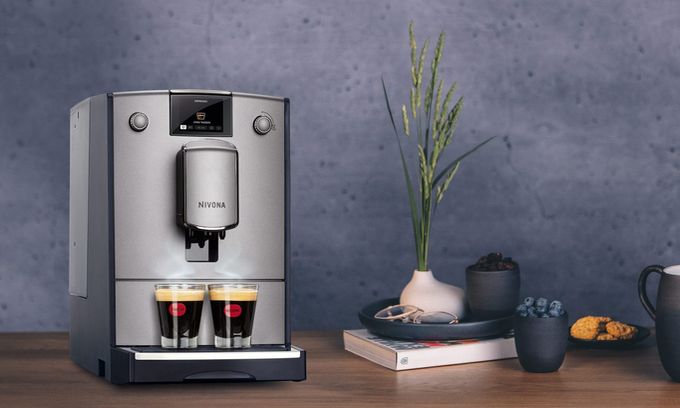In 2005, engineers Peter Wildner, Thomas Meier and Hans Errmann with extensive experience in the coffee machine industry created Nivona Apparate GmbH, Nuremberg, Germany. Later, the eminent Swiss Eugster/Frismag company became Nivona’s OEM (original equipment manufacturer) supplier. Today Nivona produces coffee machines on the Eugster Frismag AG factories in Switzerland (7,8,9 and 10 series) and Portugal (5,6 and 7 series). For reference, Eugster/Frismag also actively cooperates with Jura, Bosch and Melitta. In fact, it and Saeco (Saeco, Philips and Gaggia) are today the world’s leading manufacturers of automatic coffee machines. But to be fair, DeLonghi coffee machines are made in Italy, China, and the USA without their participation.
Current Nivona line includes 5, 6, 7, 8, 9 and 10 series.
This year Nivona has already expanded its entry-level series by introducing the NICR 550 / 560 instead of the discontinued 520 model. In fact, the new color dialogue display has become its main improvement. Not resting on their laurels, the company introduced the expansion of the 6 series, including the Nivona NICR 690 CafeRomatica (black) and NICR 695 with a dark gray ‘titanium look’ front panel.
Previous models of the 6th series, including the NICR 660/670/675/680, differed from the previous 5th series (520/525/530) in the display, setting the pre-wetting duration of the coffee tablet and a built-in Bluetooth module with Nivona app support via smartphone. Given the color display in the NICR 550 / 560, the list of differences between the series has been reduced to just pre-wet adjustment and a Bluetooth module. Therefore, the improvement of the 6th series is quite logical.
In fact, the new module that combines a coffee dispenser with a cappuccinatore has become its main improvement, almost completely automating the preparation of coffee and milk drinks.
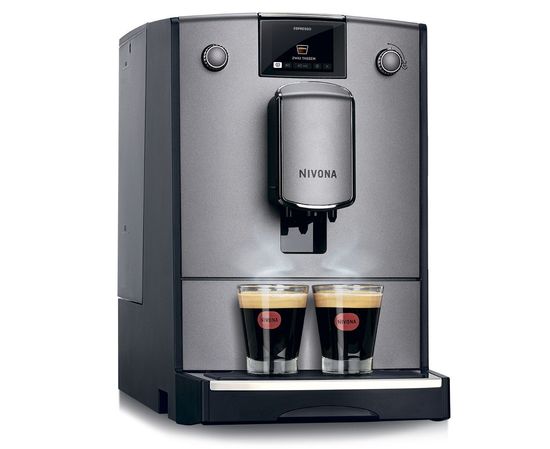
Сappuccinatore
In the 5th and 6th series the automatic cappuccinatore is located to the right of the coffee dispenser.
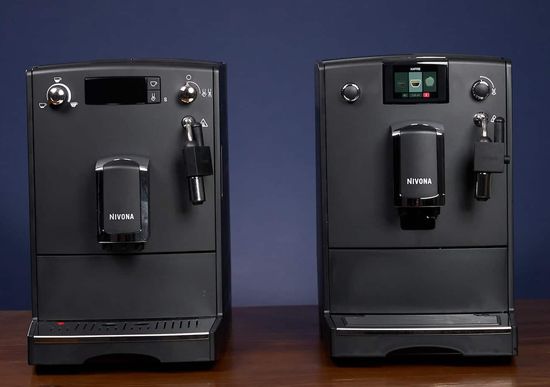
Accordingly, the preparation of coffee and milk froth are two separate processes with the cup movement between dispensers. Such models are usually positioned as semi-automatic. Fully automatic models make coffee milk drinks ‘in one touch’, without moving the cup. In this case, coffee and milk foam dispensers are structurally combined in one module.
Previously, the company used this design in the 7/8/9/10 series. Now this list has expanded due to the 6th series. But start/stop steam for milk frothing is still manually controlled via the dial to the right of the display. In fact, the new design only eliminates the cup movement.
As a result, the company added a cappuccino recipe with separate settings for the amount of coffee and milk froth, accurate to the milliliter. In fact, the new coffee machine differs from models with a fully automatic milk system only by the need to turn the steam dial twice to start/stop frothing. Strictly speaking, this does not quite correspond to the concept of ‘in one click’. But it leaves the possibility of experimenting with the milk frothing duration, which affects the foam consistency.
Also, combining them into one module has simplified the preparation of Americano (espresso + hot water). Its preparation in previous Nivona 660/670/675/680 also requires shifting the cup because hot water is added from the cappuccinatore. In new program, the coffee machine makes and pours espresso, then asks you to open the cappuccinatore to add water and prompts you to close it, depending on the set portion size.
Moreover, this design slightly increased the max cup height and the accuracy of height adjustment, virtually eliminating splashing while pouring drinks into a cup.
Cappuccinatore key features
Its design is identical to that used in the 7 (NICR 79x) and 8 (NICR 820/821/825) series, and consists of 7 components.
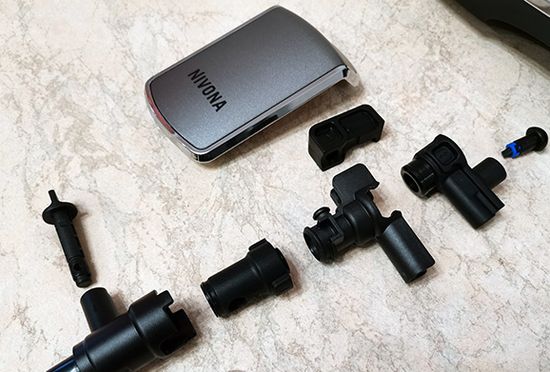
This module uses an innovative suction of air at the same time from above and from the side, providing a higher milk foam temperature.
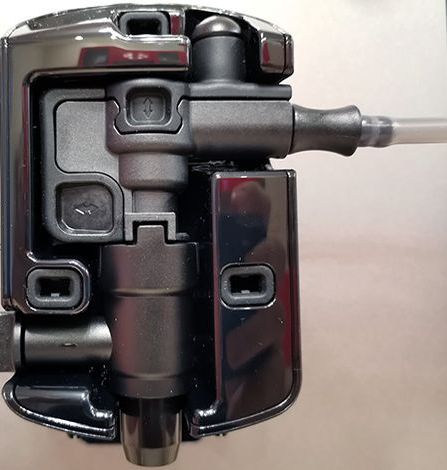
This design change allowed the developers to increase the milk foam temperature to 62°C.
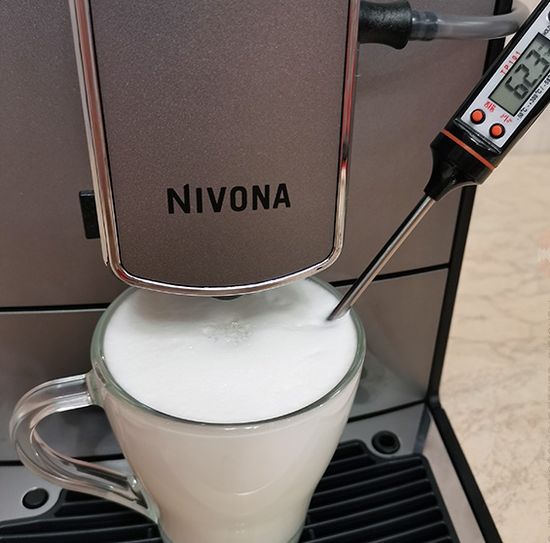
As a result, the temperature of its cappuccino reaches 66°C. As known, the temperature of a classic cappuccino varies from 65°C to 70°C.
Like previous models, NICR 690 / 695 has a separate switch on the milk frother for quick rinsing.
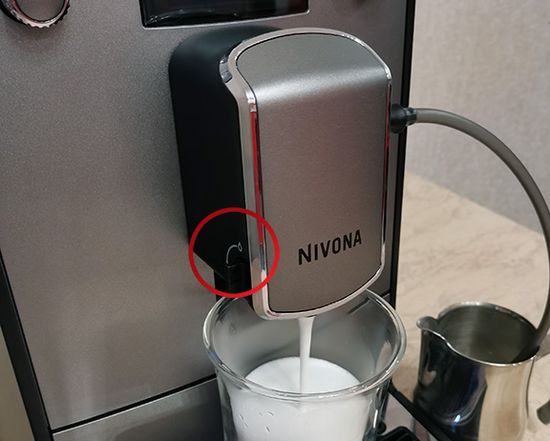
As known, milk protein and fat quickly dry out in the channels of milk system, preventing its normal operation. Therefore, any automatic cappuccinatore requires a quick rinse after use, and the switch makes this task easier.
In fact, this is the only difference between the new cappuccinatore and its version in the 7 series models. A quick rinse requires turning the switch for a few seconds and returning to its original position. Before rinsing, the drain hose must be parked in the special opening on the drip tray.
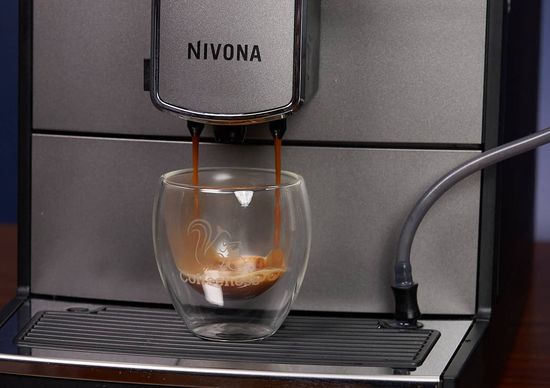
After turning the switch, the coffee machine flushes the hose. After returning to the starting position, the device rinses the cappuccinatore module with hot water and steam. What’s more, unlike the Nivona 550/560, the NICR 690/695 rinses the entire system without an additional water tank. In general, the functionality of the new cappuccinatore has almost reached the level of fully automatic milk systems.
Programs
In fact, the number of one-click programs characterizes the model automation level. Modern entry-level models offer a few programs + water/milk. Premium models support more than 10 basic programs. But the absolute record today belongs to DeLonghi ECAM Eletta Explore with 40 pre-programmed recipes.
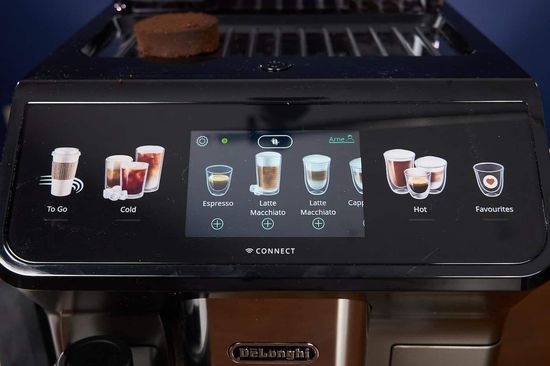
Of course, some programs duplicate the preparation of identical drinks with small nuances, but their number is impressive.
NICR 690/695 offers 6 basic recipes and saves 5 user programs with their own settings. Compared to the new NICR 550 / 560, this list has expanded with ‘cappuccino’ and ‘americano’:
– espresso (default 40 ml, mid temperature 2 out of 3, mid strength 3 out of 5, pre-wetting with a pause of 1 sec) – adjustment range 20 – 240 ml in 10 ml increments;
– coffee (an identical recipe with a much larger volume, known as Lungo, default 120 ml at medium settings) – 20 – 240 ml in 10 ml increments;
– cappuccino (non-classical – the coffee machine pours milk foam into the cup and adds coffee; by default 160 ml milk + 40 ml espresso) – adjustment: milk 40 – 240 ml, espresso 20 – 240 ml.
The model limits the total volume of the drink up to 360 ml. Accordingly, setting one of the ingredients to 240 ml limits the volume of the other to 120 ml. The tuning step is 5 ml;
– americano (classic americano, default 40 ml espresso, then 80 ml water) – adjustment range for each ingredient is 20 – 240 ml . Limitation for max volume and setting step identical to cappuccino;
– milk foam (150 ml) – 40 – 240 ml in 10 ml increments;
– hot water (150 ml) – 50 – 500 ml in 25 ml increments.
Controls
The new bright TFT display is very convenient.
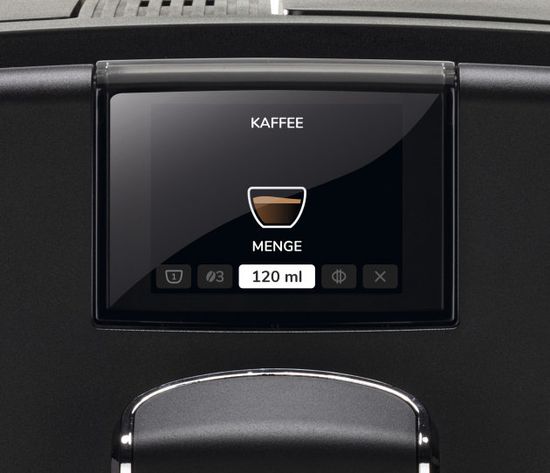
A separate submenu “My coffee” is intended for 5 user programs. They are created on the basis of preset recipes with personal settings. Moreover, the user can give them names. But selecting letters using dial is not very convenient.
Probably 11 icons for 6 pre-installed and 5 user programs could fit in the main menu without using submenus. But, this solution requires a reduction in their size. As a result, the developers decided in favor of their convenient visualization and using an additional submenu.
The 6 series coffee machines use intuitive programming of drinks. To increase the unification level, the company uses the same main board with firmware for different series.
Clear and convenient animated tooltips and icons are considered to be among the best in the industry today. Even users without barista and digital electronics skills will quickly master the controls without a traditional manual.
Importantly, the new models do not require confirmation of rinsing in the hydraulic circuit by a separate press at each start. Many users spoke extremely negatively about this redundant option.
In addition, developers use a simple but very convenient way to switch to programming mode in new models. It’s based on controlling the duration of pressing the dial (few seconds). After switching to this mode, the choice of settings is carried out by rotating and pressing the dial. It can hardly be positioned as an innovation, but the range of adjustments with only one controls has expanded significantly.
Settings
1- five levels of coffee strength:
– 7 / 9 / 11 / 13 / 15 grams of ground coffee per serving for black coffee without milk;
– 7 / 8 / 9 / 10 / 11 grams per serving of cappuccino.
In this mode, the coffee machine uses only 11 grams even with the max strength setting. Accordingly, the coffee tablet thickness and coffee grinder duration are reduced. Therefore increasing the coffee component saturation in the ‘cappuccino’ program requires separate preparation of milk froth and espresso. However, the preparation of a classic latte is carried out in a similar way. Therefore, the restriction of 11 grams will be inconvenient only for fans of strong latte macchiato.
2- three settings for the duration of pre-wetting for coffee tablet.
This setting offers ‘Dynamic’ without pre-wetting, ‘Constant’ with a 1 second pause, and ‘Intense’ with a longer pre-wetting.
3- ingredient proportions.
Editing the amount of coffee, milk and water for cappuccino and americano using the dial is done in a submenu which is located in the main ‘volume’ menu.
4- three settings of coffee temperature.
Icons at the bottom right with a down arrow, top left and right provide recipe save, exit and start, respectively.
In addition, the model has a mechanical grinding adjustment of the steel conical coffee grinder, which is located behind the right cover next to the removable brewing unit.
The coffee bean hopper holds 250 grams and, unlike the NICR 550 / 560, uses an optical sensor of beans.
In general, the platform, including a 2.2 liter water container, a 15 bar Sysko SPX.H100 water pump, a 1450W flow-through thermoblock, a coffee grounds container for 10-12 servings, a ground coffee bypass shaft with an opening sensor is similar to coffee machines of 5 and 7 series.
Nivona NICR 690/695 vs 550/560
Nivona NICR 690/695 is about € 100 more expensive (from € 500 vs € 400). In principle, the difference of 20% is quite significant, but it’s quite justified. The list of differences includes:
– cappuccino and americano programs + 5 custom recipes;
– settings for pre-wetting duration, 5 vs 3 levels of coffee strength + optical sensor of coffee beans;
– 66°C vs 63°C cappuccino temperature (classic 65-70°C).
In addition, the coffee dispenser and cappuccinatore of Nivona 690/695 are combined in one module, providing height adjustment up to 140 mm. Also, the new design does not require moving the cup when preparing coffee-milk drinks or lungo. Finally, it has a cuplight and rear wheels, ensures quick rinsing of the cappuccinatore without an additional water container, and comes with a Claris filter.
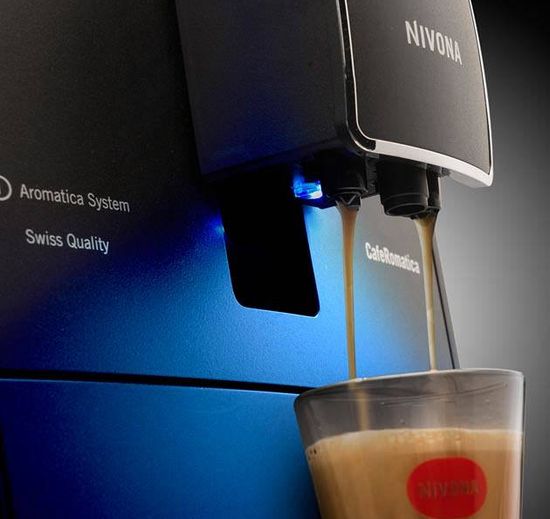
Both machines use Aroma Balance’s patented three extraction profile system.
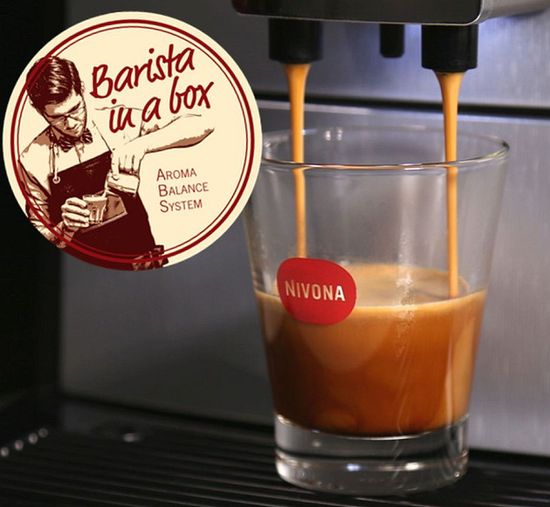
Conclusions
In addition to the improved 7th series, including NICR 79x models, Nivona introduced Nivona NICR 550/560 CafeRomatica coffee machines and significantly improved NICR 690/695. The German company’s coffee machines offer unprecedented usability, high taste qualities of drinks with the Aroma Balance system (three extraction profiles), simple care and premium reliability. Given their great value for money, the models have superb marketing prospects. Based on specs and functionality, the NICR 690/695 can be positioned as a mid-budget model with a very reasonable price of ~ € 500. Unfortunately, the strategy of selling only in specialized stores with qualified sales assistants simplifies the choice of the optimal model, but significantly limits their popularity.
In addition, the current marketing situation in this segment is slightly distorted due to the legendary DeLonghi Magnifica S ECAM 22.110. This phenomenally popular model of the Italian giant has been successfully competing in the market since 2014. Today it sells for less than € 300, offering superb value for money. But to be fair, it mainly competes with the NICR 550 / 560. In addition, DeLonghi has already introduced the new entry-level Magnifica Start series at just over € 400, which replaces the DeLonghi Magnifica S. In this case, the NICR 550/560 will compete with the new DeLonghi Magnifica series.
This video introduces the new Nivona NICR 690 and 695 models of 6 Series.
